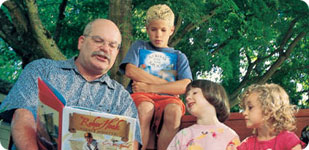There once was a boy who dreamed of becoming a writer.
When his grandmother settled down in an overstuffed chair to tell an Eastern European folktale, he was the first to sit cross-legged at her feet.
He read Grimm's fairy tales until the book fell to tatters. Later, when the boy grew into a young man, he attended a respected college. There he learned both to savor great writing and to write with precision himself. “Make every word count!” he was told over and over.
After graduation he faced his first truly scary moment-he rolled a very blank, very white piece of paper into his typewriter. It was then the boy realized what a large chasm lay between fantasizing about and truly becoming a writer. It took him 15 years to cross the chasm. On the way he was a teacher and a college professor and a storyteller.
This boy is Eric Kimmel '67, now the author of more than 50 children's books including one selected for the prestigious Caldecott Honor award.
“I'm a very, very lucky person because I always wanted to be an author, and now I am,” Kimmel recently told a group of readers during an online chat sponsored by Scholastic Books. “Although it took me a long time to get here.”
Kimmel's own story begins in Eastern Europe where his grandmother was born. She lived with Kimmel's family in Brooklyn until her death when he was 18.
“My grandma came from a little town that has been in five different countries since the beginning of the last century. It was a very diverse part of the world and a very mysterious place,” he says. “She was a great storyteller. She could tell stories that would make your hair stand on end.”
From his grandmother and his own reading of fairy tales, Robert Louis Stevenson, and Mark Twain, Kimmel acquired the itch to write. It remained only a vague notion, however, until he arrived at Lafayette in 1967.
WRITER JOURNEY BEGINS
“In college, my idea of being a writer solidified,” Kimmel says. “One of the best preparations to be a writer is to be a reader. I was an English major and at Lafayette I read the best in European and American literature. The English faculty was excellent. They pounded it into us: 'Say what you mean!' Focus! Be sharp! Be clear!'” he recalls.
Kimmel immersed himself in comparative and Russian literature courses taught by (first name) Brown and William W. Watt.
Although he was acquiring some of the tools of a writer, Kimmel didn't do much of his own writing at Lafayette. “I didn't write for the student newspaper because I didn't really like journalism all that much,” he says. “I wanted to make up my own stories. I didn't do anything at Lafayette to advance my career in any concrete way, but I was formulating the idea that it would be nice to be a writer.”
Graduating in 1967, Kimmel faced a dual dilemma: he needed to support himself and there was a good chance he would be drafted for the Vietnam War, which he actively opposed. Teaching, with its deferment status, was an answer to both. He taught in New York and the Virgin Islands before returning to school to complete his doctorate in education at the University of Illinois.
“Although after college I went on to get several graduate degrees, the best teaching experience I had in my life was at Lafayette,” Kimmel says. “When I taught college students, I modeled myself on the teachers at Lafayette-they knew their subjects backwards and forwards and never came in unprepared.”
At the University of Illinois something serendipitous occurred. Kimmel, who had long nurtured an interest in children's literature, encountered a group of storytellers. “I started hanging out with them and doing storytelling programs in parks and libraries,” he says. “Storytelling is great preparation for writing for children because when a child says, 'Tell me a story' you'd better make it good.”
During the next 17 years, Kimmel taught education, first at Indiana University in South Bend and later at Portland State in Oregon, where he lives with his wife, Doris. All the while he continued storytelling, writing children's books, and was a frequent contributor to Cricket magazine.
CALDECOTT NOMINATION
“I was having moderate success with my writing and then, at the end of the 1980s, something began to click,” Kimmel says. “Hershel and the Hanukkah Goblins was a runner-up for the Caldecott and that's when I started to take another look at my writing. I wondered what I could do if I gave 100 percent of my time to writing. I took a sabbatical, spent the time writing and traveling and, in 1993, left the university to write full-time.”
Today, Kimmel is a respected author of more than 50 children's books, most for students in grades four, five, and six. Some are original stories, others retellings of old folktales, and still others a combination of the two.
Now that he's settled into his writing niche, would Kimmel ever consider trying another genre? “I've never been interested in writing for adults-I don't think I'm much of an adult myself,” he says with a chuckle. “I think children are the best audience. They bring an intensity to reading that no adult can match.”

